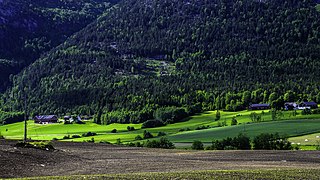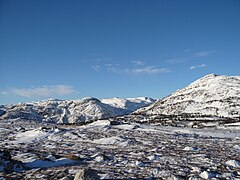Bø, Telemark
This article needs to be updated. (January 2020) |
Bø Municipality
Bø kommune | |
|---|---|
|
| |
 Telemark within Norway | |
 Bø within Telemark | |
| Coordinates: 59°27′26″N 9°1′53″E / 59.45722°N 9.03139°E | |
| Country | Norway |
| County | Telemark |
| District | Midt-Telemark |
| Administrative centre | Bø i Telemark |
| Government | |
| • Mayor (2011) | Olav Kasland (V) |
| Area | |
| • Total | 263 km2 (102 sq mi) |
| • Land | 258 km2 (100 sq mi) |
| • Rank | #292 in Norway |
| Population (1.1.2015) | |
| • Total | 5,977 |
| • Rank | #188 in Norway |
| • Density | 20/km2 (50/sq mi) |
| • Change (10 years) | |
| Demonym | Bøhering[1] |
| Official language | |
| • Norwegian form | Nynorsk |
| Time zone | UTC+01:00 (CET) |
| • Summer (DST) | UTC+02:00 (CEST) |
| ISO 3166 code | NO-0821[3] |
| Website | Official website |
Bø is a village and municipality in Telemark county, Norway. It is part of the traditional region of Midt-Telemark, but was historically regarded as part of Grenland. The administrative centre of the municipality is the village of Bø i Telemark ("Bø in Telemark"). Bø has been a settlement since ancient times, a parish since the middle ages and became a municipality (formannskapsdistrikt) in 1838. The area of Lunde was separated from Bø in 1867 to become a separate municipality. Bø has a population of 5,977 (2015).
Bø's economy is mainly based on agriculture, forestry, tourism, education and public administration. Bø has the character of a university town and is home to one of the principal campuses of the University of Southeast Norway; it was also the seat of one of the university's three predecessor institutions, Telemark University College. Bø is well known for its cultural traditions within traditional music and artisanship, and its central position within Norwegian national romanticism with e.g. its Bunad traditions. Bø has several times been called "the most beautiful place on earth" in modern literature, e.g. in Bjørnstjerne Bjørnson's story En glad Gut (A Happy Boy).
General information
Name
The municipality (originally the parish) is named after the old Bø farm (Old Norse: Bœr), since the first church was built here. The name is identical with the word bœr which means "homestead" or "farm".[4]
Coat-of-arms
The coat-of-arms is from modern times. They were adopted on 19 February 1988. The arms show three gold-colored fiddles on a red background. Bø is historically known for its musical tradition, as well as the production of fiddles (similar to the hardingfele). The fiddle was thus chosen as an appropriate symbol for the municipality.[5][6]
Education
In 1923 the county of Telemark decided to start a secondary school in Bø, the equivalent of today's middle school or "ungdomsskole", called Telemark Realskole. At this time secondary schools mostly existed in the larger towns and cities, and most youngsters ended their schooling after 7 years. It was the county's intention to expand this school to a high school as soon as practically possible. This happened in 1947, and the school's name was Telemark Offentlige Landsgymnas. The existence of this school made it possible to establish Telemark College (Distriktshøgskulen i Telemark), which evolved into Telemark University College.
Attractions
Bø is famous for its waterpark Sommarland (the largest of its kind in Norway). Another tourist site in Bø is the Gygrestol rock formation. There is also Kroa i bø, one of the oldest music venues in Norway. The club won the award for "Concert promoter of the Year 2005" and is based on voluntary work from students of the Telemark University College.


Bø Old Church
Bo Church (Bø kyrkje) dates from ca. 1100. The church is in stone and has 200 seats. It was built in the Romanesque style, with long church plan and choir to the east. The sanctuary, choir loft and the apse are from the Middle Ages, whereas the narthex was built to the 1600s.[7]
Bø Church
Bø New Church (Bø kyrkje) dates from 1875. The church is wooden and has 450 seats. The church was built in Neo-Gothic style. There are wood carvings on the altarpiece, pulpit, lectern and west gallery.[8]
Notable residents

- Johan Henrik Rye (1787–1868) a military officer, jurist and President of the Storting
- Jon Eriksson Helland (1790 in Bø – 1862) a Norwegian Hardanger fiddle maker
- Olaf Rye (1791 in Bø – 1849) a Norwegian-Danish military officer
- Nils Nilsen Ronning (1870 in Bø – 1962) an American author, journalist and editor
- Olav Gunnarsson Helland (1875 in Bø – 1946) a Norwegian Hardanger fiddle maker
- Neri Valen (1893 in Bø – 1954) politician, Mayor of Bø in 1922
- Halvor Vreim (1894 in Bø – 1966) an architect, saved old wooden buildings
- Olav Kielland (1901–1985 in Bø) a composer and conductor, lived in Bø from 1955
- Hallvard Eika (1920–1989) politician, Mayor of Bø, 1967–1970
- Halvor Kleppen (born 1947 in Bø) a media personality, theme park owner and writer
- Geir Barvik (born 1958 in Bø) civil servant; MD the Norwegian State Housing Bank to 2010
- Margunn Bjørnholt (born 1958 in Bø) a Norwegian sociologist, economist and academic
- John-Arne Røttingen (born 1969 in Bø) medical scientist, CEO of the Research Council of Norway
- Varg Vikernes (born 1973) musician, writer and convicted murderer, lived in Bø after his release
- Øyvind Storesund (born 1975 in Bø) a rock and jazz musician, plays upright bass
- Håkon Anton Fagerås, (grew up in Bø) a sculptor
- Webjørn S. Espeland, (Norwegian Wiki) (born 1979 in Bø) radio personality
Sport
- Anders Haugen (1888 in Bø – 1984) an American ski jumper bronze medallist at the 1924 Winter Olympics
- Hans Kleppen (1907 in Bø – 2009) a ski jumper, participated in the 1928 Winter Olympics
- Runar Steinstad (born 1967 in Bø) a paralympian athlete, bronze medallist at the 2012 Summer Paralympics
- Elbasan Rashani (born 1993) a Kosovan professional footballer with over 200 club caps, grew up in Bø
Sister cities
The following cities are twinned with Bø:[9]
Gallery
-
Bø Station
-
Mølleplassen
-
Farm in Bø
-
Farms in Bø
-
Oterholtfossen
-
Lifjell
-
A typical farm house in Børte
References
- ^ "Navn på steder og personer: Innbyggjarnamn" (in Norwegian). Språkrådet.
- ^ "Forskrift om målvedtak i kommunar og fylkeskommunar" (in Norwegian). Lovdata.no.
- ^ Bolstad, Erik; Thorsnæs, Geir, eds. (2023-01-26). "Kommunenummer". Store norske leksikon (in Norwegian). Kunnskapsforlaget.
- ^ Rygh, Oluf (1914). "11. Bø Herred". Norske gaardnavne: Bratsbergs amt (in Norwegian) (7 ed.). Kristiania, Norge: W. C. Fabritius & sønners bogtrikkeri. p. 197.
- ^ Norske Kommunevåpen (1990). "Nye kommunevåbener i Norden". Retrieved 2009-01-17.
- ^ "Kommunevåpen og ordførarkjede" (in Norwegian). Bø kommune. Archived from the original on 2011-07-24. Retrieved 2009-01-17.
- ^ "Bø gamle kyrkje, Bø i Telemark". Den norske kirke. Retrieved October 1, 2016.
- ^ "Bø kyrkje, Bø i Telemark". Den norske kirke. Retrieved October 1, 2016.
- ^ "Vennskapskommunar" (in Norwegian). Bø kommune. Archived from the original on 2011-07-24. Retrieved 2009-01-17.
External links
 Media related to Bø at Wikimedia Commons
Media related to Bø at Wikimedia Commons The dictionary definition of Bø at Wiktionary
The dictionary definition of Bø at Wiktionary- Municipal fact sheet from Statistics Norway
 Telemark travel guide from Wikivoyage
Telemark travel guide from Wikivoyage- Bø Sommarland waterpark (in Norwegian)
- Kroa i Bø music venue










